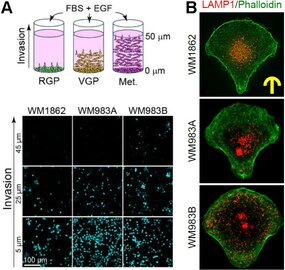- Key facts: this study highlights the crucial role of the intracellular position of lysosomes in melanoma progression. By analyzing patient-derived melanoma cells and biopsies, the researchers demonstrated that the peripheral dispersion of lysosomes promotes tumor aggressiveness, notably by facilitating extracellular matrix degradation and cell invasion.
- Significantly, by using chemical and genetic tools to modify the position of lysosomes, the consortium showed that their clustering around the nucleus (perinuclear position) significantly reduces the invasive capacity of tumor cells, both in mouse models and in zebrafish.
- Why is this important? This research demonstrates for the first time that the position of lysosomes within the cell can regulate tumor invasion, opening up new perspectives in the diagnosis and treatment of metastatic melanoma.
Congratulations to the MIC team for their contribution!
Jerabkova-Roda, K., Peralta, M., Huang, KJ. et al. Peripheral positioning of lysosomes supports melanoma aggressiveness. Nat Commun 16, 3375 (2025).
https://doi.org/10.1038/s41467-025-58528-5
Illustration: 3D migration of melanoma cells in collagen gel correlates with their grade of malignity (A). High-grade melanomas (metastatic; WM983B) show significant dispersion of lysosomes (red spots), which is responsible for their tumour aggressiveness (B).


